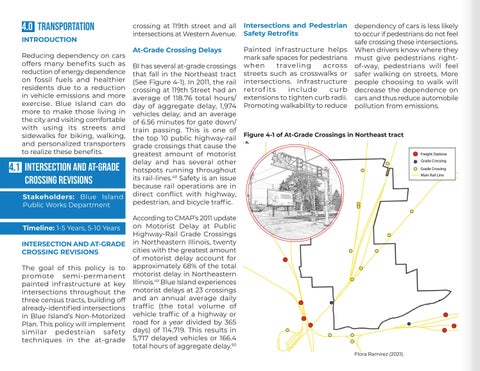4.0 Transportation INTRODUCTION Reducing dependency on cars offers many benefits such as reduction of energy dependence on fossil fuels and healthier residents due to a reduction in vehicle emissions and more exercise. Blue Island can do more to make those living in the city and visiting comfortable with using its streets and sidewalks for biking, walking, and personalized transporters to realize these benefits.
4.1 Intersection and At-Grade Crossing Revisions Stakeholders: Blue Island Public Works Department Timeline: 1-5 Years, 5-10 Years INTERSECTION AND AT-GRADE CROSSING REVISIONS The goal of this policy is to promote semi-permanent painted infrastructure at key intersections throughout the three census tracts, building off already-identified intersections in Blue Island’s Non-Motorized Plan. This policy will implement similar pedestrian safety techniques in the at-grade
crossing at 119th street and all intersections at Western Avenue.
Intersections and Pedestrian Safety Retrofits
At-Grade Crossing Delays
Painted infrastructure helps mark safe spaces for pedestrians when traveling across streets such as crosswalks or intersections. Inf rastructure retrof its include curb extensions to tighten curb radii. Promoting walkability to reduce
BI has several at-grade crossings that fall in the Northeast tract (See Figure 4-1). In 2011, the rail crossing at 119th Street had an average of 118.76 total hours/ day of aggregate delay, 1,974 vehicles delay, and an average of 6.56 minutes for gate down/ train passing. This is one of the top 10 public highway-rail grade crossings that cause the greatest amount of motorist delay and has several other hotspots running throughout its rail-lines.48 Safety is an issue because rail operations are in direct conflict with highway, pedestrian, and bicycle traffic.
dependency of cars is less likely to occur if pedestrians do not feel safe crossing these intersections. When drivers know where they must give pedestrians rightof-way, pedestrians will feel safer walking on streets. More people choosing to walk will decrease the dependence on cars and thus reduce automobile pollution from emissions.
Figure 4-1 of At-Grade Crossings in Northeast tract
According to CMAP’s 2011 update on Motorist Delay at Public Highway-Rail Grade Crossings in Northeastern Illinois, twenty cities with the greatest amount of motorist delay account for approximately 68% of the total motorist delay in Northeastern Illinois.49 Blue Island experiences motorist delays at 23 crossings and an annual average daily traff ic (the total volume of vehicle traffic of a highway or road for a year divided by 365 days) of 114,719. This results in 5,717 delayed vehicles or 166.4 total hours of aggregate delay.50 Flora Ramirez (2021).


























